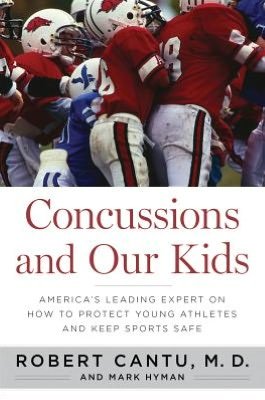Youth football impact study yields surprises
- Created on Thursday, 01 March 2012 08:13
- Last Updated on 31.01.2013
- Published Date
 Less mass, less speed, less strength would lead one to believe that seven- and eight-year-old football players experience impacts of minimal force.
Less mass, less speed, less strength would lead one to believe that seven- and eight-year-old football players experience impacts of minimal force.
Not so, say researchers from the Center for Injury Biomechanics at Virginia Tech - Wake Forest University who recently released the results of a new study.
Big forces
A total of 748 impacts were recorded from seven players who wore helmets outfitted with 12 accelerometers each.
https://The researchers tracked impact data for all practices and games for one season.
Forces associated with the hits (linear accelerations) ranged from 10 to 100 g, a measure of force as it relates to gravity. By comparison, a fighter pilot in an F-16 is prepared to "pull" eight or nine g's.
"Higher forces do not always cause concussions," said Dr. Thomas Trojian, Sports Medicine Fellowsip Director and team physician at the University of Connecticut. "Currently, the relationship between force and injury causation has not been fully discovered. Higher forces in one location can cause concussions whereas the same force in another area will not."
The paper is published in the Annals of Biomedical Engineering and is available online for free download.
High impact drills should be eliminated
The majority of the higher impacts, those above 40 g, occurred during practices. The researchers state that high impact drills should be eliminated from practices and note that the forces found during practice are not typically found during game play. The NFL and eight Ivy League schools instituted new rules in 2011 that reduce contact during practices in order to minimize the risk of concussion.
Ongoing research
Based on the importance of this initial publication, the School of Biomedical Engineering and Sciences is implementing a new study to instrument and map the head impact exposure of youth football players for all age groups from 6 years through 18 years. This program will consist of over 240 instrumented helmets on six different football teams in Virginia and North Carolina.
Called the Kinematics of Impact Data Set (KIDS), it is anticipated that this research program will greatly enhance the understanding of child brain biomechanics and will lead to improvements in youth practice and game techniques as well as the development of improved helmets specifically designed for children. The study is the first of its kind to look at the full age spectrum from age 6 to 18.
As part of the KIDS study,https://eam will receive new helmets and new sensors fitted inside the helmet. Each time a player impacts his head, data are recorded and wirelessly downloaded to a computer on the sideline. The technology is similar to what Virginia Tech has used since 2003 to instrument its collegiate football team. The research conducted with the Virginia Tech football team has led to a better understanding of head impacts in football and how they relate to concussions.
The KIDS project will utilize Simbex’s Head Impact Telemetry System (HITS) technology in football helmets. This technology has been in use since 2003 at Virginia Tech. The KIDS study builds upon Virginia Tech's ongoing multi-year, multi-institution study of head impact exposure together with Simbex, Dartmouth College, and Brown University funded by the National Institutes of Health that has focused on college athletes and has resulted in more than 20 peer-reviewed publications to date.
It is anticipated that over 50,000 head impacts will be recorded through 2012 as part of this KIDS project. These data have implications that are not limited to improved youth football techniques and helmets, but also has applications towards improved head protection in other sports, as well as advancements in automobile safety designs.
Source: Newswise -- February 22, 2012
Questions/comments? contact Jean Rickerson at This email address is being protected from spambots. You need JavaScript enabled to view it.
Brain Health
It is rare for a sports-related concussions to result in a more serious injury such as a skull fracture or hematoma. Nonetheless, it pays to be aware that catastrpohic injuries do sometimes occur as ...
read more...-
CT scans may increase brain cancer risk
Children and young adults scanned multiple times by computed tomography (CT), a commonly used dia...
-
Sub-concussive impacts may affect learning
MINNEAPOLIS – A new study suggests that head impacts experienced during contact sports such as ...
-
Physical activity boosts learning
INDIANAPOLIS – School administrators looking to restructure the academic schedule should consid...




Neuroscience
Athens, Ga.- University of Georgia researchers have developed a map of the human brain that shows great promise as a new guide to the inner workings of the body's most complex and critical organ.
...
read more...-
Does CTE infect neuron to neuron?
NFL Hall of Famer "Iron Mike" Webster's life ended in 2002 when he suffered a heart attack at age...
-
Progesterone seems to protect neurons after injury
It is not yet known why girls suffer concussions at a higher rate than boys. The most prevalent...
-
Amino acids may restore concussion's chemical imbalance
Concussions are often called the "invisible" injury because they are usually not detectable by t...
Resources
- School professionals play an important role in the health of all students. Recognizing the signs and symptoms of concussion is important, as is managing their return to school ...
- https://
- CDC's Concussion Training for Clinicians
-
Concussion Education Video Programs - Free and Easy
Parents, athletes, coaches and medical professionals have access to concussion education created...
-
New concussion guidelines for team physicians
INDIANAPOLIS – Team physicians who assess and treat athletes suspected of concussion have new ...
quick links
Latest News
Concussions Occur...
...in Any Sport
REMOVE athlete from play
REFER to medical provider
REST no sports, no texting/TV
RETURN only with doctor's OK
Source: Children's Hospital Boston, Sports Concussion Clinic


































